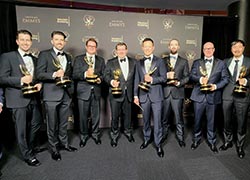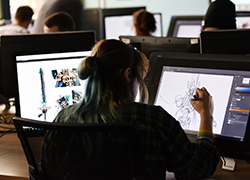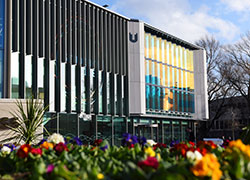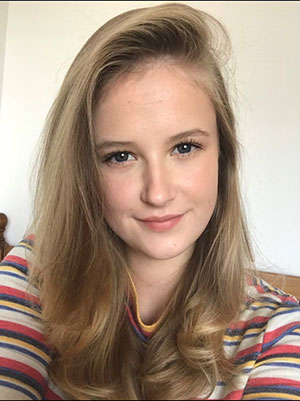Course overview
Visual effects and motion graphics student showreel 2025
Check out the work from our talented BA (Hons) Visual Effects and Motion Graphics students.
You blend computer-generated elements with live-action footage to produce scenes that are impossible to capture in real life. You merge technical expertise with artistic creativity, producing alien worlds, massive crowds, or fire-breathing dragons on our screens.
You gain experience of the whole production pipeline including previsualisation, motion design, technical animation, effects animation, look development and compositing, and develop your own specialism. By blending computer-generated and live-action footage, you create scenes that can only be developed with creative and technical expertise.
You have access to our new digital production stage featuring motion capture and an LED wall, our immersive experience space and dedicated studios using industry standard hardware and software.
This course includes a foundation year - ideal if you need additional preparation or if you don't have sufficient grades to join Year 1 of a degree.
Top reasons to study visual effects and motion graphics at Teesside
- £2,000 Accommodation Award: you may be eligible for £2,000 towards your accommodation fees if you live outside the TS postcode and are in your first year of study on a games or animation course. Find out more.
- International acclaim: ranked 19th in the world in the Animation Career Review International Animation School Rankings 2024. (Top 50 International Animation Colleges – formal degree. 195 colleges considered). Find out more at tees.ac.uk/source.
- SideFX recognition: this course has been officially certified by SideFX and the school is a member of the SideFX Certified Partner Programme in recognition of our knowledgeable instructors, the high quality of student work, and our efforts devoted to connecting students to industry.
- ScreenSkills recognition: this course is industry recognised by ScreenSkills, the industry-led skills body for the UK’s screen-based industries, and carries the ScreenSkills Select quality-mark which indicates courses best suited to prepare students for a career in the screen industries.

Course details
Course structure
Foundation year core modules
You are introduced to the creative possibilities of image-making using digital tools. Study the fundamental principles of design and composition, and explore a range of image creation techniques. Use appropriate graphics software to improve your technical skills incorporating layers, composition, colour, linework and lighting.
This is a 30-credit module.
Focusing on computer games, animation and film, you gain an introductory level of understanding in the context of your chosen field of study. As well as looking at the historical and context of these, you observe how we interpret these types of media historically and materially. Choose a text within your area of interest, undertaking an analytical review in the form of a case study.
This is a 30-credit module.
Drawing, Creativity and Design
Learn to create imagery using traditional and digital drawing tools. Develop your drawing techniques and creative interpretations of themes including figure drawing, still life, perspective and character, creature and environment design. You are supported to produce images that effectively communicate visual ideas.
This is a 30-credit module.
You produce an individual project with guidance from your tutor. Gain independent working and project management skills, developing original ideas and concepts in your chosen field. This could be in the form of a piece of concept art, animation or another appropriate form related to creative industries.
This is a 30-credit module.
Year 1 core modules
The principles of animation are the foundation stone for any animator. Originally created by Disney, they have been used by generations of animators to create convincing animation across movies, TV series, games and commercials.
Fundamentals of 2D animation
Learn the principles of 2D animation, using hand-drawn techniques to create animation exercises.
Fundamentals of 3D animation
Explore the principles of 3D animation using industry standard techniques and software using a range of methods including the layered method and pose to pose.
Animation in context
Delve into the history of animation and motion design, from its earliest beginnings to today’s diverse styles and applications.
This is a 30-credit module.
You’re introduced to the 3D asset production, look development pipeline and the creation of production ready 3D assets using industry standard techniques and software.
Asset creation
You learn how to create 3D models, incorporating principles of topology, efficiency, and suitability.
3D texturing
Edit and apply captured, procedural and painted textures to 3D objects, using UV maps and image editing software.
CG lighting
Create attractive lighting for 3D objects and scenes, studying topics such as direct and indirect lighting, light types, shadows and colour temperature.
Rendering
Study physically based rendering techniques including theory, practice, rendering passes, layers and the rendering pipeline.
This is a 30-credit module.
You are introduced to a variety of technical areas of animation and VFX production.
Character and prop rigging
Learn the principles of forward and inverse kinematics, joints and skeletons, skinning and weight painting and applying control rigs.
Motion capture
Use the motion capture studio to learn how to direct actors and capture motion. Learn to clean data, apply it and import it into a real time engine.
Visual effects
Develop skills in simulation and procedural VFX to enhance rigid body dynamics, cloth, hair, fur and creature FX.
This is a 30-credit module.
Visual Development for the Moving Image
When planning and visualising sequences for animation and live action, you need to understand the pre-production process and the tools and techniques you can use.
Cinematography and film language
You are introduced to cinematography and learn about film language, shot composition, camera moves and lighting.
Character and storyboard development
Develop your own visual interpretation of a script or narrative and produce a moving storyboard (animatic).
Digital compositing
You are introduced to a range of compositing techniques for live-action and 3D computer-generated imagery, 2D and stop-motion animation, lighting and digital 2D painted backgrounds.
This is a 30-credit module.
Year 2 core modules
Explore destruction effects, using industry standard techniques to create VFX shots. You look at fracturing, rigid body dynamics, particle systems and fluid effects. You study motion graphics design tools and techniques including motion effects generation, motion design and layout and animating to music. You also study the history of motion graphics and the iterative development of a sequence.
You work in a team to produce an animation or visual effects sequence based on an industry style brief. Experience working in a production environment with industry input and feedback, and target specific production skills in your chosen field of study.
This is a 30-credit module.
Professional Practice and Ethical AI Assisted Creativity
You get the opportunity to experiment in a specialist area of your choice in animation, games and visual effects. Develop your independent learning skills and take ownership of your chosen direction through the assessment. You also research professional roles related to your specialism, identifying the graduate skills you need and developing an online presence.
AI literacy improves employability, making you more competitive in the job market. You also investigate the responsible use of AI in animation and visual effects, focusing on the benefits, risks and ethical concerns such as IP, copyright and consent.
This is a 30-credit module.
You explore the VFX and digital compositing pipeline. From planning and acquisition, through to the final output of a finished shot. You study the techniques required to produce visual imagery using industry standard software as you develop skills in creating seamless composited motion sequences integrating live action, CG content and photographed elements.
Optional work placement year
You have the option to spend one year in industry learning and developing your skills. We encourage and support you with applying for a placement, job hunting and networking.
You gain experience favoured by graduate recruiters and develop your technical skillset. You also obtain the transferable skills required in any professional environment, including communication, negotiation, teamwork, leadership, organisation, confidence, self-reliance, problem-solving, being able to work under pressure, and commercial awareness.
Many employers view a placement as a year-long interview, therefore placements are increasingly becoming an essential part of an organisation's pre-selection strategy in their graduate recruitment process. Benefits include:
· improved job prospects
· enhanced employment skills and improved career progression opportunities
· a higher starting salary than your full-time counterparts
· a better degree classification
· a richer CV
· a year's salary before completing your degree
· experience of workplace culture
· the opportunity to design and base your final-year project within a working environment.
If you are unable to secure a work placement with an employer, then you simply continue on a course without the work placement.
Final-year core modules
Work alongside your project supervisor to develop a large-scale piece of individual work relating to your chosen specialism and career aims.
This is a 60-credit module.
You choose from a selection of briefs which reflect specialist industry roles, such as realistic creature animation, effects simulation or puppet making. Explore your specialism and develop your professional skills such as pitching ideas, costing and scheduling, working to a tight brief and responding to client changes.
This is a 30-credit module.
You work in a team to produce a short film or visual effects sequence in a style of your choice. It could be a high-end visual effects sequence, a motion graphics title sequence or a short film. Each member takes on a production role to mimic the industry pipeline. You gain experience of teamwork, and a showpiece for your portfolio.
This is a 30-credit module.
Modules offered may vary.
How you learn
A variety of learning and teaching methods are employed throughout the programme. The methods adopted reflect active learning using authentic approaches, due to the vocational nature of the course. Team working is featured throughout the course will prepare you for the formal group assessment in years 2 and 3. External guest speakers, seminars and workshops on current research and emerging topics are also a course feature. These will include inquiry-based learning and activities that mirror research process in the discipline. Additionally, they provide you with a bibliography of important and recent academic and professional research publications in the discipline.
How you are assessed
We believe that it is essential for you to learn through the experience of doing. Assessment for all modules is in the form of practical projects, which you work on throughout each year. In Year 2, the Moviola module provides you with essential teamwork skills ready for industry. The Project in the final year allows you the freedom to set your own project based on your skills, interests and career aspirations.
Our Disability Services team provide an inclusive and empowering learning environment and have specialist staff to support disabled students access any additional tailored resources needed. If you have a specific learning difficulty, mental health condition, autism, sensory impairment, chronic health condition or any other disability please contact a Disability Services as early as possible.
Find out more about our disability services
Find out more about financial support
Find out more about our course related costs
Entry requirements
2026-27 entry requirements
For Clearing 2025 entry requirements, please refer to the information in the box above.
Any combination of level 3 qualifications. Each application is considered on a case-by-case basis.
We may also be able to help you meet the entry requirements through our Summer and Winter University modules.
For general information please see our overview of entry requirements.
Are you an international student looking for a foundation course offering both academic and English language content? Explore your options with our International Study Centre.
International applicants can find out what qualifications they need by visiting Your Country.
You can gain considerable knowledge from work, volunteering and life. Under recognition of prior learning (RPL) you may be awarded credit for this which can be credited towards the course you want to study.
Find out more about RPL
Employability
Career opportunities
You have many opportunities to develop your professional skills, links with industry and meet with recruiters through our Expo Series, Animex Festival and Student Futures activities.
Graduates from our Visual Effects degrees have gone on to enjoy successful careers in studios around the world working on visual effects for film, television, animation and games.
Graduates have gone on to work in a range of areas including previs, modelling, rigging, production, effects animation, matte painting, tracking and matchmove, lighting, look development and compositing. They are working for companies including Industrial Light and Magic, Weta Digital, Double Negative, Moving Picture Company, Cinesite, The Third Floor, The Mill, Pixar, Digital Domain, Framestore and many more.
Information for international applicants
Qualifications
International applicants - find out what qualifications you need by selecting your country below.
Select your country:
Useful information
Visit our international pages for useful information for non-UK students and applicants.

 Emmy success for Teesside University graduate
Emmy success for Teesside University graduate New scholarship will help break down barriers to the animation and games industries
New scholarship will help break down barriers to the animation and games industries Global ranking for animation at Teesside
Global ranking for animation at Teesside